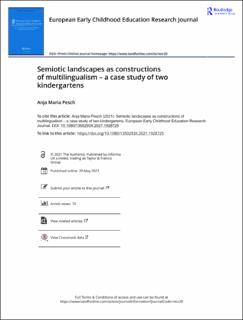| dc.contributor.author | Pesch, Anja Maria | |
| dc.date.accessioned | 2021-09-24T08:39:21Z | |
| dc.date.available | 2021-09-24T08:39:21Z | |
| dc.date.created | 2021-06-07T17:35:56Z | |
| dc.date.issued | 2021 | |
| dc.identifier.citation | European Early Childhood Education Research Journal. 2021, 1-19. | en_US |
| dc.identifier.issn | 1350-293X | |
| dc.identifier.uri | https://hdl.handle.net/11250/2781322 | |
| dc.description | © 2021 The Author(s). Published by Informa UK Limited, trading as Taylor & Francis Group This is an Open Access article distributed under the terms of the Creative Commons Attribution-NonCommercial-NoDerivatives License (http://creativecommons.org/licenses/by-nc-nd/4.0/), which permits non-commercial re-use, distribution, and reproduction in any medium, provided the original work is properly cited, and is not altered, transformed, or built upon in any way | en_US |
| dc.description.abstract | This article explores the construction of multilingualism in the semiotic landscapes of two kindergartens, one in Norway and one in Germany. Semiotic landscape is here understood as the visual linguistic environment, including various semiotic resources, such as texts, symbols, drawings or pictures. In kindergarten, semiotic landscapes construct and transform views on languages and multilingualism as well as pedagogical aims. The data material for this study was collected during ethnographic fieldwork. Using a nexus analytic approach the paper explores which discourses on multilingualism are constructed in the semiotic landscapes, whose voices are represented and which interaction order they involve. While the semiotic landscape in the Norwegian kindergarten constructs the kindergarten as multilingual, the semiotic landscape in the German kindergarten points to a predominance of German. However, a closer analysis also shows practices that erase linguistic diversity and devalue multilingualism in the Norwegian kindergarten and practices that encourage multilingualism in the German kindergarten. An important part of this is the oral communication practice which at times contrasts the overall discourses in the semiotic landscapes. | en_US |
| dc.language.iso | eng | en_US |
| dc.rights | Attribution-NonCommercial-NoDerivatives 4.0 Internasjonal | * |
| dc.rights.uri | http://creativecommons.org/licenses/by-nc-nd/4.0/deed.no | * |
| dc.subject | semiotic landscape | en_US |
| dc.subject | multilingualism | en_US |
| dc.subject | discourse | en_US |
| dc.subject | language ideology | en_US |
| dc.subject | ethnographic research | en_US |
| dc.subject | nexus analysis | en_US |
| dc.title | Semiotic landscapes as constructions of multilingualism – a case study of two kindergartens | en_US |
| dc.type | Peer reviewed | en_US |
| dc.type | Journal article | en_US |
| dc.description.version | publishedVersion | en_US |
| dc.subject.nsi | VDP::Samfunnsvitenskap: 200::Pedagogiske fag: 280 | en_US |
| dc.source.pagenumber | 1-19 | en_US |
| dc.source.journal | European Early Childhood Education Research Journal | en_US |
| dc.identifier.doi | 10.1080/1350293X.2021.1928725 | |
| dc.identifier.cristin | 1914281 | |
| cristin.ispublished | true | |
| cristin.fulltext | original | |
| cristin.qualitycode | 2 | |

